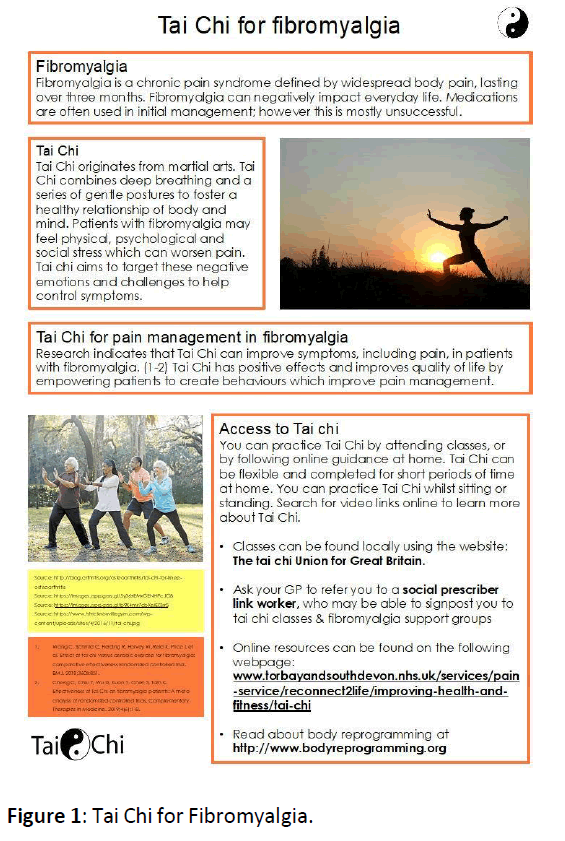Implementing Tai Chi for Fibromyalgia
Rebecca Carole Wood
DOI10.36648/2471-982X.21.7.34
Rebecca Carole Wood*
Department of Medicine, University of Exeter Medical School, Knowledge Spa, Royal Cornwall Hospital Trust (RCHT), Truro, England
- *Corresponding Author:
- Rebecca Carole Wood
Department of Medicine
University of Exeter Medical School
Knowledge Spa
Royal Cornwall Hospital Trust (RCHT)
Truro, England
Tel: 01872 256400
E-mail: rw548@exeter.ac.uk
Received Date: March 02, 2021 Accepted Date: March 16, 2021 Published Date: March 22, 2021
Citation: Wood RC (2021) Implementing Tai Chi for Fibromyalgia. Int J Anesth Pain Med Vol.7 No.2:34
Abstract
Chronic pain conditions, including fibromyalgia (FM), are often exacerbated by psychological and social factors. Clinicians regularly manage FM with analgesic medications; however, this frequently fails to be successful. Meditative movements, such as Tai Chi, could be an intervention that improves pain management in patients with FM. An ever-growing body of research suggests that Tai Chi exerts significant positive effects on improving pain management, whilst also improving quality of life. The implementation of Tai Chi, nonetheless, provides a challenge. Furthermore, research fails to consider home based practice, compared to supervised classes. Overall, Tai Chi could empower patients to adopt lifestyle changes which improves pain management and symptom control. Access to mindfulness based exercise requires further consideration and implementation.
Keywords
Fibromyalgia; Chronic pain; Tai Chi
Introduction
Fibromyalgia (FM) is a chronic pain condition, affecting up to 2-8% of the population [1]. Alongside chronic pain, patients can experience sleep disturbances, fatigue and memory problems. Clinicians often use pharmacotherapy to manage patients with FM, unfortunately this is frequently insufficient [2]. Meditative movements such as Tai Chi could help with the management of FM. Research indicates that Tai Chi can improve pain management in FM, significantly more than aerobic exercise and standard care [3]. Furthermore, longer durations (>24 weeks) of practising Tai Chi exerts better outcomes, with cumulative pain relief [4]. Therefore, it seems Tai Chi is a lifestyle intervention that should be promoted for patients with FM.
Home-Based Practice
Whilst research provides positive insight into the management of FM, some areas of knowledge remain to be investigated. There is limited research into supervised Tai Chi interventions compared to self-care practice.
Although home based mindfulness practice been investigated, research has yet to explore home based practice of Tai Chi compared supervised classes. This is im porta nt con sideration, ability to practice Tai Chi at home could increase uptake and accessibility to patients [5]. Furthermore, Tai Chi is a low impact exercise with minimal side effects.
Meditative movements could provide multiple health benefits, which adds to its desirability as an interventi on for both patients and clinicians [6].
Implementing Tai Chi
Implementing Tai Chi could be challenging, in which my prior research highlights. Research fails to consider how to implement Tai Chi within the community. There is insufficient funding within the National Health Service (NHS), especially given the current COVID-19 pandemic [7].
In light of this, I created an information resource to be distributed in general practices and pain clinics.(Figure 1) seems the challenge is not quantifying results but transforming the research into an accessible intervention for patients.
The educational resource outlines ways to access Tai Chi online, and how to search for classes. Further modes to increase access to Tai Chi could involve social prescribing. However, the next step forward would be to distribute the resource via general practices and quantify the outcome using a survey.
If the results indicate a positive outcome, the project could be expanded, whilst further educating patients and clinicians on Tai Chi.
Conclusion
Overall, my research highlights the multiple health benefits of Tai Chi as a method of improving pain management in patients with FM. However, more research is needed into home based practice compared to supervised intervention. Implementing Tai Chi remains a challenge. Firstly, an educational resource could improve access to Tai Chi. If the outcomes are quantified, an added step would be to increase access of Tai Chi via social prescribing. Such an intervention could have multiple health benefits, and thus is desirable to patients and clinicians.
Acknowledgements
I would like to thank Dr Anna Weiss, consultant in anaesthesia and pain medicine, for supporting me with this project.
References
- Claw JD (2014) Fibromyalgia-A Clinical Review. JAMA 311: 1547.
- Claw JD (2021) Fibromyalgia-Symptoms, diagnosis and treatment. BMJ Best Practice.
- Tai Chi (2021) Tai Chi & Qigong Union for Great Britain.
- Wood RC (2020) Tai Chi as a method of improving pain management in patients with fibromyalgia. Lifestyle Medicine.
- Lloyd A, White R, Eames C, Crane R (2017) The utility of home-practice in mindfulness-based group interventions: A Systematic Review. Mindfulness 9: 673-692.
- Solloway M, Taylor S, Shekelle P, Miake-Lye I, Beroes J, et al. (2016) An evidence map of the effect of Tai Chi on health outcomes. Systematic Reviews.
- The King's Fund (2021) NHS funding: Our position.
Open Access Journals
- Aquaculture & Veterinary Science
- Chemistry & Chemical Sciences
- Clinical Sciences
- Engineering
- General Science
- Genetics & Molecular Biology
- Health Care & Nursing
- Immunology & Microbiology
- Materials Science
- Mathematics & Physics
- Medical Sciences
- Neurology & Psychiatry
- Oncology & Cancer Science
- Pharmaceutical Sciences

